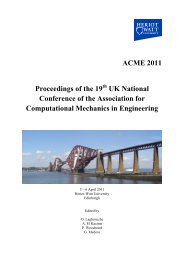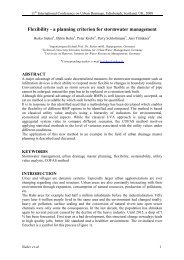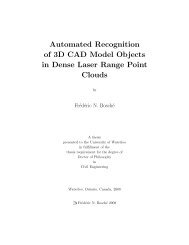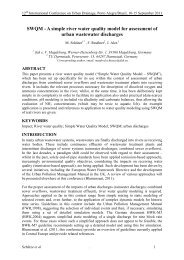ADESBA - A new general global control system applied to the ...
ADESBA - A new general global control system applied to the ...
ADESBA - A new general global control system applied to the ...
You also want an ePaper? Increase the reach of your titles
YUMPU automatically turns print PDFs into web optimized ePapers that Google loves.
12 th International Conference on Urban Drainage, Por<strong>to</strong> Alegre/Brazil, 11-16 September 2011<br />
Since 2007, <strong>the</strong> Hildesheim urban drainage department implements a step-wise optimisation<br />
of <strong>the</strong> throttle settings. In a fur<strong>the</strong>r step in 2010, with <strong>the</strong> implementation of <strong>the</strong> RTC <strong>system</strong>,<br />
<strong>the</strong> dynamic <strong>control</strong> of <strong>the</strong> s<strong>to</strong>rm-water overflow tanks was fur<strong>the</strong>r optimised. For this purpose,<br />
on <strong>the</strong> basis of <strong>the</strong> KOSIM model, first of all, a hydrological sewer network model was<br />
set up in SIMBA, thus allowing <strong>to</strong> simulate and <strong>to</strong> analyse <strong>the</strong> <strong>control</strong> algorithms in a very<br />
flexible way. The model was calibrated and verified. Figure 2 presents a comparison between<br />
<strong>the</strong> simulated and <strong>the</strong> measured wastewater treatment plant inflows.<br />
Figure 2. Results from verification at <strong>the</strong> inflow of WWTP of Hildesheim<br />
In this period (23.7.-3.8.2007) 450,681 m³ of wastewater flowed in<strong>to</strong> <strong>the</strong> WWTP. Due <strong>to</strong><br />
infiltration water flows from <strong>the</strong> catchments with separate sewer networks, <strong>the</strong> simulation<br />
results matches <strong>the</strong> inflow data roughly by 93%. If <strong>the</strong> results are compared separately only<br />
for <strong>the</strong> part of <strong>the</strong> combined sewer catchments <strong>the</strong> difference amounts <strong>to</strong> only 1%.<br />
Examples of changes in <strong>the</strong> disposal of surplus quantities of s<strong>to</strong>rm sewage brought about in<br />
<strong>the</strong> 23.7.-3.8.2007 period can be taken from Table 1 (cf Figure 2). As at this time operation of<br />
<strong>the</strong> throttle discharges involved stationary optimisation at 4 tanks, this variant is also shown.<br />
Table 1. Simulated CSO discharges during <strong>the</strong> period 23.7. - 3.8.2007<br />
CSO (m³)<br />
Stationary throttle <strong>ADESBA</strong>-<strong>control</strong> box<br />
without opti- with optimization at 4 tanks 9 tanks<br />
mization<br />
4 tanks<br />
Mastbergstr. 208 301 301 0<br />
Cheruskerring 3.187 2.397 2.397 2.347<br />
Speicherstr. 801 907 907 318<br />
Schützenallee 9.196 7.251 6.123 6.731<br />
Alter Markt 2.124 2.124 2.124 305<br />
Treibestr. 3.966 3.966 2.347 2.612<br />
Hohnsen 4.169 4.169 2.413 2.514<br />
Lönsbruch 537 537 537 156<br />
Tank WWTP 0 0 0 20<br />
Total 24.188 21.652 17.149 15.003<br />
Reduction 10,5 % 29,1 % 38,0 %<br />
Maximum use of<br />
Tank WWTP<br />
34 % 38 % 84 % 100 %<br />
4 <strong>ADESBA</strong> - A <strong>new</strong> <strong>general</strong> <strong>global</strong> <strong>control</strong> <strong>system</strong>













